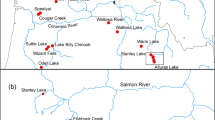In 1996 and 1997, the spawning behavior of fluvial white-spotted charr Salvelinus leucomaenis, was observed in the upstream area of an erosion control dam. A small number of males with relatively large body size mated successfully with females as a pair, while almost all satellite males did not sneak successfully, resulting in a non-random mating system. The low sneaking success of subordinate males, in addition to the monopolization of spawning opportunities by a few dominant males, is one of the most important causes of skewed reproductive success among males. The total number of adult fishes in the study area (N: approximately half of the whole tributary above a dam) was estimated as 148 and 102 in 1996 and 1997, respectively. Based on these findings and some further assumptions, the estimated effective population size (Ne) was low in both years. The Ne/N ratio ranged from 0.33 to 0.36 in both years. In addition to reduced population size by construction of an impassable dam, the above-dam population suffered low Ne due to skewed reproductive success among males. The low Ne may be one cause of extinction in above-dam populations of fluvial charr, especially just after the construction of impassable barriers.
Similar content being viewed by others
References
Bartley D., Bagley M., Gall G., Bentley B. (1992) Use of linkage disequilibrium data to estimate effective size of hatchery and natural fish populations. Conservation Biology 6: 365–375.
Blanchfield P. J. & Ridgway M. S. (1999) The cost of peripheral males in a brook trout mating system. Animal Behaviour 57: 537–544.
Caro T. (1998) Behavioral Ecology and Conservation Biology. Oxford University Press, Oxford.
Creel S. (1998) Social organization and effective population size in Carnivores. In: Behavioral Ecology and Conservation Biology. (ed. T. Caro) pp. 246–270. Oxford University Press, Oxford.
Fleming I. A. (1996) Reproductive strategies of Atlantic salmon: ecology and evolution. Reviews for Fish Biology and Fisheries 6: 379–416.
Frankham R. (1995) Effective population size/adult population size ratios in wildlife: a review. Genetical Research 66: 95–107.
Gross M. R. (1991) Salmonid breeding behaviour and life history evolution in changing environments. Ecology 72: 1180–1186.
Hedrick P. W. & Miller P. S. (1992) Conservation genetics: techniques and fundamentals. Ecological Application 3: 30–46.
Hino T., Maekawa K., Reynolds J. B. (1990) Alternative male mating behaviours in landlocked Dolly Varden (Salvelinus malma) in south-eastern Alaska. Journal of Ethology 8: 13–20.
Katano O. (1990) Dynamic relationships between the dominance of male dark chub, Zacco temminncki, and their acquisition of females. Animal Behaviour 40: 1018–1034.
Kawanabe H. (1988) Japanese char (r(r))s and masu salmon problems: a review. Physiology Ecology Japan 1 (Suppl.): 13–24.
Kiso K. & Kosaka S. (1994) [Iteroparity of female fluvial masu salmon, Onchorhynchus masou in a river of the southern Sanriku district, Honshu, Japan.] Suisanzoshoku 42: 71–77 (in Japanese).
Kitano S. (1996) Size-related factors causing individual variation in seasonal reproductive success of fluvial male Dolly Varden (Salvelinus malma). Ecology of Freshwater Fish 5: 59–67.
Lande R. (1995) Mutation and conservation. Conservation Biology 9: 782–791.
Lande R. & Barrowclough G. F. (1987) Effective population size, genetic variation, and their use in population management. In: Viable Populations for Conservation. (ed. M. E. Soule) pp. 87–124. Cambridge University Press, Cambridge.
McDowall R. M. (1988) Diadromy in Fishes: Migrations Between Freshwater and Marine Environments. Croom-Helm, London.
Maekawa K. (1983) Streaking behaviour of mature male parrs of the Miyabe charr, Salvelinus malma miyabei, during spawning. Japanese Journal of Ichthyology 30: 227–234.
Maekawa K. (1999) [Ecology and mountain stream fishes and some effects of erosion control dams.] In: Erosion Control and Ecological Management of Mountain Streams>. (ed. T. Ohta & G. Takahashi) pp. 89–109. University of Tokyo Press, Tokyo (in Japanese).
Maekawa K. & Goto A. (1982) [History of Freshwater Fishes in Japan.] Chuokoron, Tokyo (in Japanese).
Maekawa K., Hino T., Nakano S., Smoker W. W. (1993) Mate preference in anadromous and landlocked Dolly Varden (Salvelinus malma) females in two Alaskan streams. Canadian Journal of Fisheries and Aquatic Science 50: 2375–2379.
Maekawa K. & Nakano S. (1994) Nonoviposition of mature eggs by female fluvial red-spotted masu salmon. Fisheries Science 60: 37–39.
Maekawa K., Nakano S., Yamamoto S. (1994) Spawning behaviour and size-assortative mating of Japanese charr in an artificial lake-inlet stream system. Environmental Biology of Fishes 39: 109–117.
Maekawa K. & Onozato H. (1987) Reproductive tactics and fertilization success of mature male Miyabe charr, Salvelinus malma miyabei. Environmental Biology of Fishes 15: 119–129.
Mjølnerød I. B., Fleming I. A., Refseth U. H., Hindar K. (1998) Mate and sperm competition during multiple-male spawnings of Atlantic salmon. Canadian Journal of Zoology 76: 70–75.
Nakano S., Kitano F., Maekawa K. (1996) Potential fragmentation and loss of thermal habitats for charrs in Japanese archipelago due to climatic warming. Freshwater Biololgy 36: 711–722.
Wooton R. J. (1990) Ecology of Teleost Fishes. Chapman & Hall, London.
Author information
Authors and Affiliations
Corresponding author
About this article
Cite this article
Maekawa, K., Koseki, Y., Iguchi, K. et al. Skewed reproductive success among male white-spotted charr land-locked by an erosion control dam: Implications for effective population size. Ecol Res 16, 727–735 (2001). https://doi.org/10.1046/j.1440-1703.2001.t01-1-00429.x
Received:
Accepted:
Issue Date:
DOI: https://doi.org/10.1046/j.1440-1703.2001.t01-1-00429.x




